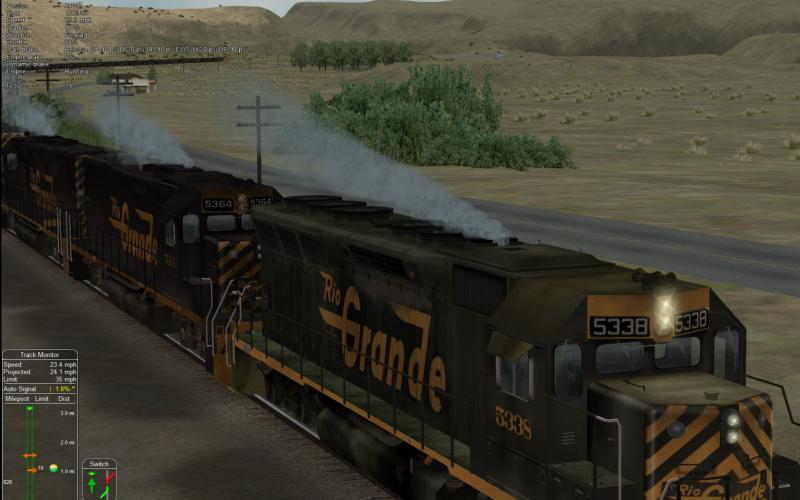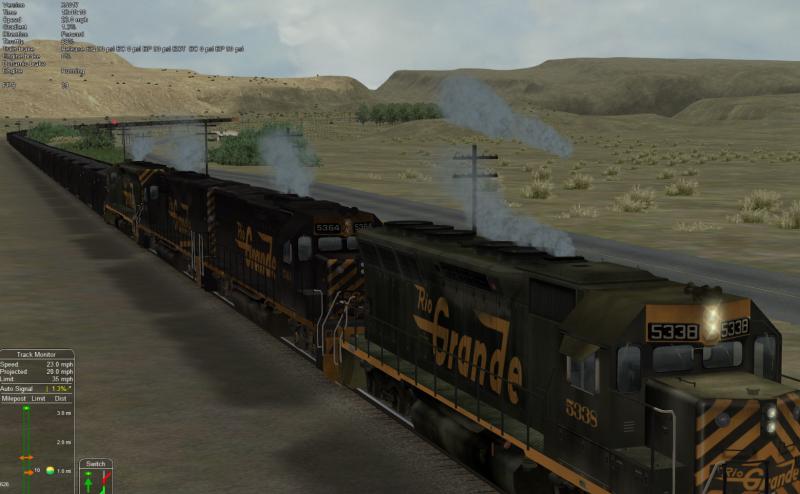http://www.elvastowe...780&qpid=230730
 ErickC, on 31 December 2017 - 07:34 PM, said:
ErickC, on 31 December 2017 - 07:34 PM, said:
...and what i have seen in X4017 --- there appears to something in the code that allows exhaust characteristics from the default msts file to be rendered in the sim when using a OpenRails folder .eng file. As shown below. There are two screenshots. One with a single exhaust that appears to be too low in "y" axis. Adjusting the "y" axis in the OR include file produces...TWO exhaust plumes??? Obviously the higher plume is the result of the adjustment to the include file, the lower plume still being read from the default msts eng file.
I am assuming that Eric and the others are seeing this dual effect also, but being manifested in a different manner?
Using the ORTS diesel engine block, I still see the exhaust color changes rendered in the sim. White, grey, black, and bluish idle smoke - all present.
Log attached, although nothing in it to indicate this effect.
Single Exhaust Plume
include ( "..\\DRGW_SD45_5338.eng" ) Wagon ( include ( "..\\..\\Common.Std\\Locomotives\\Std_TypeF_Coupler.inc" ) include ( "..\\..\\Common.Std\\Locomotives\\Std_Loco_BrakesTS.inc" ) ORTSAdhesion ( ORTSCurtius_Kniffler ( 7.5 44 0.161 0.7 ) ) ORTSAdhesion ( ORTSSlipWarningThreshold ( 70 ) ) ORTSBearingType ( Roller ) ORTSDavis_A ( 1896.44 ) ORTSDavis_B ( 57.9457 ) ORTSDavis_C ( 8.337645 ) Comment( == Assumptions -Locomotive diesel/electric - speed - 65mph (105km/h), Roller Bearing, 6 axles, frontal area - 14.5m2, WagonWeight - 176.1 ton (metric), Drag 1.0 == ) ) Engine ( Effects ( DieselSpecialEffects ( Exhaust1 ( 0 4.59 2.2 0 1 0 0.14 ) ) ) include ( "..\\..\\Common.Std\\Locomotives\\Std_Eng_SD45.inc" ) )
default msts eng file
Engine ( DRGW_SD45_5338
Effects
(
DieselSpecialEffects
(
Exhaust1
(
0 4.59 2.2
0 1 0
0.15
)
)
)
Wagon ( DRGW_SD45_5338)
Type ( Diesel )Dual Plumes (msts default and OR include
Engine ( DRGW_SD45_5338
Effects
(
DieselSpecialEffects
(
Exhaust1
(
0 4.59 2.2
0 1 0
0.15
)
)
)
Wagon ( DRGW_SD45_5338)
Type ( Diesel )OR include with "y" axis raised
include ( "..\\DRGW_SD45_5338.eng" ) Wagon ( include ( "..\\..\\Common.Std\\Locomotives\\Std_TypeF_Coupler.inc" ) include ( "..\\..\\Common.Std\\Locomotives\\Std_Loco_BrakesTS.inc" ) ORTSAdhesion ( ORTSCurtius_Kniffler ( 7.5 44 0.161 0.7 ) ) ORTSAdhesion ( ORTSSlipWarningThreshold ( 70 ) ) ORTSBearingType ( Roller ) ORTSDavis_A ( 1896.44 ) ORTSDavis_B ( 57.9457 ) ORTSDavis_C ( 8.337645 ) Comment( == Assumptions -Locomotive diesel/electric - speed - 65mph (105km/h), Roller Bearing, 6 axles, frontal area - 14.5m2, WagonWeight - 176.1 ton (metric), Drag 1.0 == ) ) Engine ( Effects ( DieselSpecialEffects ( Exhaust1 ( 0 6.59 2.2 0 1 0 0.14 ) ) ) include ( "..\\..\\Common.Std\\Locomotives\\Std_Eng_SD45.inc" ) )
Attached File(s)
-
 OpenRailsLog.txt (13.91K)
OpenRailsLog.txt (13.91K)
Number of downloads: 377

 Log In
Log In Register Now!
Register Now! Help
Help







